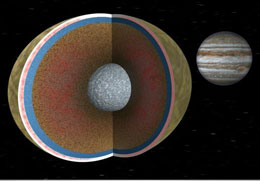Jupiter: Moons: Europa
 |  |  |  |  |  here for complete caption." border="0" hspace="1" vspace="1"> here for complete caption." border="0" hspace="1" vspace="1"> |  |  |  |  |  | In this movie Europa is seen in a cutaway view through two cycles of its 3.5 day orbit about the giant planet Jupiter.Click image for the movie. Click here for complete caption. |  |  |  |  |
|
Jupiter's icy moon Europa is slightly smaller than the Earth's moon. Like the Earth, Europa is thought to have an iron core, a rocky mantle, and a surface ocean of salty water. Unlike on Earth, however, this ocean is deep enough to cover the whole surface of Europa, and being far from the Sun, the ocean surface is globally frozen over.
Europa orbits Jupiter every 3.5 days and is phase locked -- just like Earth's moon -- so that the same side of Europa faces Jupiter at all times. However, because Europa's orbit is eccentric (i.e. an oval not a circle) when it is close to Jupiter the tide is much higher than when it is far from Jupiter. Thus tidal forces raise and lower the sea beneath the ice, causing constant motion and likely causing the cracks we see in images of Europa's surface from visiting robotic probes.
This "tidal heating" causes Europa to be warmer than it would otherwise be at its average distance of about 780,000,000 kilometers (485,000,000 miles) from the sun, more than five times as far as the distance from the Earth to the Sun. The warmth of Europa's liquid ocean could prove critical to the survival of simple organisms within the ocean, if they exist.